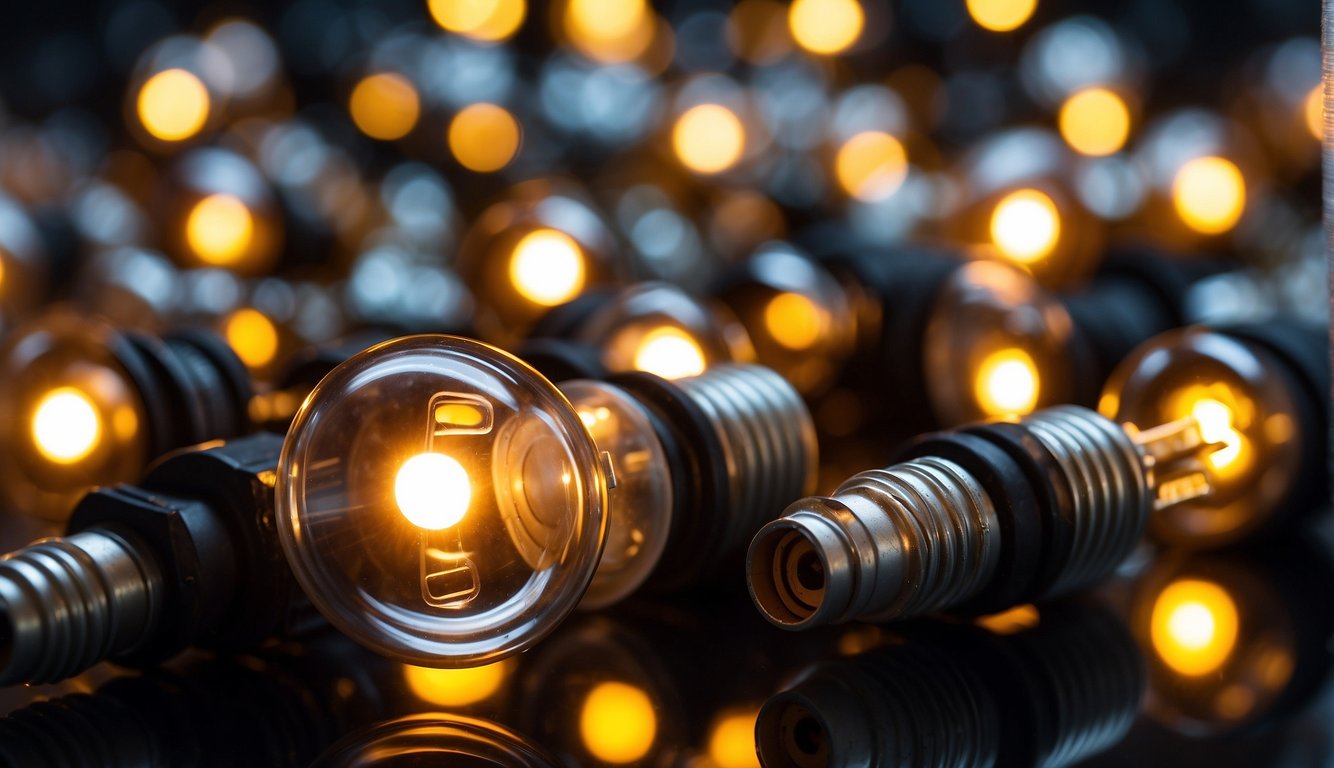Light bulbs for RVs are an essential component that can enhance your travel experience by providing proper illumination inside and around your vehicle. Upgrading or maintaining your RV lighting is not only about visibility but also about energy efficiency and setting the right ambiance for your home on wheels. Whether you are parked at a campsite or on the road, the right lighting can make a significant difference to both the functionality and the coziness of your RV.

Considering the variety of options available, understanding the basics of RV lighting is crucial before making any changes or upgrades. It’s important to choose light bulbs that are compatible with your RV’s electrical system, and to consider factors such as power consumption, the color of light, and the desired brightness. LED bulbs are increasingly popular in RVs due to their long life and low energy usage, but other options may be more suitable depending on your specific lighting needs and preferences.
Key Takeaways
- Proper lighting enhances visibility and ambiance in your RV.
- Choosing the right bulbs involves considering compatibility and power usage.
- LED bulbs offer longevity and efficiency for RV travelers.
Understanding RV Lighting Basics
When setting up your recreational vehicle (RV) for a journey, ensuring proper lighting is crucial. Efficient lighting not only provides comfort during your travels but also ensures safety within and outside your RV.
Types of RV Light Bulbs
Your RV is likely equipped with various light bulb types, each serving a unique purpose. Traditional incandescent bulbs have been common, but LEDs are now the go-to choice for their longevity and energy efficiency. Discover how energy-saving properties of LED bulbs can enhance your RV experience. Fluorescent fixtures might still be present in some RVs but are becoming less common. Meanwhile, halogen bulbs emit a bright, warm light and are often used in headlamps.
Importance of Correct Bulb Size
Finding the correct bulb size for your RV lighting is not just about fitting it into the socket; it’s about ensuring the appropriate light dispersal throughout your space. An ill-fitting bulb can cause poor illumination or even damage the fixture. Follow guides on replacing your RV lights to ensure that your space is well lit and your fixtures remain in good shape.
Voltage Considerations for RVs
RVs typically operate on a 12v power system, which is crucial to remember when selecting bulbs for your vehicle. Ensure that the bulbs you’re purchasing are compatible with a lower voltage system to prevent electrical issues. Information on the common types of light bulbs for RV and motor homes, including voltage specifications, can help guide your selection process. Voltage considerations are integral for the safety and longevity of your RV’s electrical system.
Interior Lighting Options
When it comes to uplifting the ambiance of your recreational vehicle (RV), interior lighting plays a significant role. Brightness levels, durability, and energy consumption are key factors you’ll consider while making a choice that best suits your mobile domicile.
LED Bulbs for Indoor Use
LED bulbs are an excellent choice for indoor lighting in your RV due to their long lifespan and minimal power consumption. They come in various shapes and sizes, fitting standard sockets in your RV, and are known for their durability, making them ideal for the movement and vibration experienced during travel.
Incandescent vs LED
Incandescent bulbs have been the traditional go-to for interior lighting, but when compared to LED lights, they fall short. LED bulbs use significantly less power, which means they won’t drain your RV’s battery as quickly as incandescent bulbs do.
Selecting Color Temperature
Color temperature dramatically affects the feel of your RV’s interior. LED bulbs are available in a range of color temperatures, from warm yellows to cool whites. A warm light creates a cozy atmosphere, while a cooler light is ideal for task lighting. Opt for color temperatures around 2700K for a warm glow or go higher, like 6000K, for a crisp, daylight feel within your RV.
Energy Efficiency in Interior Lights
LED lights are more energy-efficient than traditional bulbs, making them an economical long-term investment for your RV’s interior lighting needs. Their lower heat output also makes them safer for use in the confined spaces of an RV. This can help decrease the overall energy costs and help keep your RV cool during hotter seasons.
Exterior Lighting Solutions
When considering exterior lighting for your RV, it’s essential to focus on both functionality and style. Tail lights, headlights, brake lights, and RV porch lights play crucial roles in safety and comfort during your travels.
Choosing Tail Lights
Your RV’s tail lights are vital for signaling to other drivers when you are slowing down or stopping. When choosing tail lights, look for LED options, which are energy-efficient and have a longer lifespan than traditional bulbs. For example, upgrading to LED tail lights can ensure better visibility and lower the need for frequent replacements.
RV Porch Lighting
Choosing the right RV porch light bulb affects both ambiance and safety. An LED bulb with a warm color temperature can create a cozy and inviting outdoor space. It’s wise to opt for a light with a motion sensor, adding security and convenience. Sources like CAMPERiD.com offer a variety of porch lighting solutions that could match your RV’s style and lighting needs.
Headlights and Brake Lights
Your RV’s headlights should provide clear visibility for night-time travel, so consider bulbs that offer bright, white light. Ensure that your brake lights are functioning correctly, as they alert the drivers behind you when you’re coming to a stop. Regularly inspect these lights, and replace them promptly if necessary. RV lighting blogs like Super Bright LEDs provide insights and tips on upgrading to more efficient LED options to enhance your RV’s exterior lighting.
Installing New Light Fixtures
Upgrading your RV’s lighting can not only improve the ambiance but also increase energy efficiency. When replacing light fixtures, you’re enhancing both the function and style of your motorhome.
Dome Light Installation
First, ensure you select the right dome lights that are compatible with your RV’s voltage system, typically 12V. Before starting, turn off the power to avoid electrical hazards. Remove the existing dome light cover and unscrew the base, being careful to support the fixture.
- Disconnect: Gently detach the wires connected to your old dome light.
- Connect: Attach your new dome light wires to the existing wiring in the RV. It typically involves matching wire colors—black to black, white to white.
- Secure Fixture: Attach the new dome light fixture to the ceiling, screwing it into place firmly.
- Test: Before sealing everything, turn the power back on to ensure your new light operates correctly.
« Best Light Bulbs for Epilepsy: Safe Lighting Solutions for Sensitive Individuals
Questions for Light Bulbs: Choosing the Right Illumination for Your Home »
For a step-by-step guide, see the detailed instructions on replacing RV light fixtures.
Replacing RV Headlights
Replacing the headlights in your RV can be crucial for safety during night-time travels. Make sure the replacement headlights are designed for your specific RV model.
- Remove Old Headlights: Carefully take out the old headlight bulbs. In some models, you may need to remove screws or clips to free the headlight assembly.
- Install New Bulbs: Place the new bulbs into the headlamp socket. Be cautious not to touch the glass portion of halogen bulbs with bare fingers, as oils from your skin can shorten the bulb’s lifespan.
- Reassemble: Reattach any components you removed during the disassembly process. Ensure everything is secured properly to avoid vibrations that could damage the new bulbs during travel.
If you’re upgrading to LED headlights, this will offer longer lasting and more energy-efficient lighting for your travels.
Maintaining Your RV’s Lighting
Proper maintenance of your RV’s lighting system ensures safety and comfort while you’re on the road. Here, you’ll find targeted advice on how to keep everything shining bright.
Cleaning Light Fixtures
To prevent dim lighting, regularly clean your light fixtures. Dust and dirt can accumulate, decreasing the light output. You can use a soft cloth and mild detergent to gently clean the covers. For the best results, do this at least once every few months.
Regular Bulb Checks
You should check your bulbs often to catch any that have burnt out. For this, turn on all the lights and replace any that are not working. When changing bulbs, consider upgrading RV interior lights to LED, as they last longer and use less energy than traditional bulbs.
Troubleshooting Common Issues
If you’re facing flickering lights or a bulb that won’t light up after replacement, there might be an electrical issue at hand. Check the fixture’s wiring and ensure the connections are tight. For more complex problems, consulting a professional for lighting system installation could prevent potential hazards.
LED Technology in RVs
LED lighting has revolutionized the way you light up your RV, offering significant energy savings and durability. Here’s what you need to know about integrating LED technology in your recreational vehicle.
Advantages of LED Bulbs
An immediate advantage of LED bulbs is their notable energy efficiency. Unlike incandescent bulbs that might use 1.6 amps, an LED bulb of the same size uses only around 0.12 amps, which translates to your RV needing less power to keep the lights on. This also extends the life of your vehicle’s battery.
LED lights are also known for their low heat emission, adding to their safety profile. This is particularly beneficial in the confined spaces of an RV, where reducing heat generation helps manage interior temperatures and minimize the risk of overheating or fire hazards.
LED Lifespan and Reliability
The reliability of LED lights comes from their impressive lifespan. Typically, an LED bulb can last up to 25,000 hours, far outstripping the life expectancy of incandescent or halogen bulbs. This means less frequent replacements and more time enjoying your travels without worrying about maintenance.
Understanding Aluminum Heat Sinks
LED bulbs incorporate aluminum heat sinks to manage thermal output. The aluminum material excellently conducts heat away from the LED chip, ensuring it operates within the desired temperature range. This is a crucial aspect that contributes to their longevity and consistent performance over time.
By choosing LED lights for your RV and understanding their design, like the role of aluminum heat sinks, you’re investing in a lighting solution that is both energy-efficient and reliable for the long haul.
Specialty Bulbs and Connectors

In your RV, lighting is key for both comfort and safety. Specialty bulbs come in various base types and connectors, ensuring you have the right fit and function for your needs.
Bay15d Base Bulbs
Bay15d bulbs have a unique double contact, bayonet mount base, featuring two stilted pins and a 15mm diameter. These bulbs are typically used for tail lights and brake lights in RVs, as their design prevents them from being inserted incorrectly. For RV LED replacement bulbs with a Bay15d base, you need to check the alignment and wattage to ensure they’re suitable for your vehicle’s fixtures.
- Installation Tips:
- Align the bulb’s base pins with the slots in the socket.
- Push down gently and twist to secure into place.
E26 Screw Base Options
E26 base bulbs are commonly referred to as “medium” or “standard” base bulbs. This screw base design is prevalent in RV interior light fixtures. Transitioning to RV LED replacement bulbs with an E26 base can offer longer lifespan and better energy efficiency compared to traditional incandescent bulbs.
- Advantages:
- Energy Efficiency: LEDs consume less power, saving you on battery and energy costs.
- Durability: Resilient against bumps and vibrations during transit.
When selecting bulbs, ensure the connectors match your RV’s sockets, and that the voltage rating is compatible with your vehicle’s electrical system.
Factors Affecting Power Consumption
When you’re managing your RV’s power resources, understanding the factors that contribute to power consumption is key. Finding the right balance can lead to significant energy savings and a prolonged off-grid experience.
Efficient Use of RV Lighting
Implementing strategies for efficient use of RV lighting can greatly reduce your energy usage. Consider using lighting only when necessary and making the most out of natural daylight. By strategically managing the lights you have on, you can conserve power which is especially important for boondockers or when dry camping without hookups.
Impact of Bulb Types on Energy Use
The type of bulb you choose for your RV plays a crucial role in energy use. Traditional incandescent bulbs tend to use more power due to their lower efficiency. Conversely, LED bulbs are a more energy-efficient option; they provide the same brightness but use a fraction of the power. For instance, where a 12-volt incandescent bulb might consume 1.6 amps of power, a comparable 12-volt LED may only need 0.12 amps. This difference means significant energy savings over time.
Switching to LED lighting for RVs is not only beneficial for reducing power consumption but also for improving your overall energy efficiency. Your choices in lighting directly impact the longevity of your RV’s power supply and contribute to an eco-friendlier lifestyle on the road.
Light Color and Ambiance

When outfitting your RV, the color of the light you choose plays a critical role in creating a comfortable atmosphere. Whether it’s for a relaxing vacation hideaway or a lively gathering space, the right lighting sets the tone for your RV’s interior.
Choosing Light Color for Comfort
Selecting the optimal light color for your RV’s interior lighting is essential for both comfort and functionality. While cool white lights may be beneficial for tasks that require attention to detail, warmer tones are typically recommended for living spaces within your RV. Warmer colors, ranging from soft whites to yellows, mimic the hues of incandescent bulbs and can make your space feel cozy and inviting. On the efficiency side, RV LED lights with a color temperature around 2700K to 3000K are ideal for creating a homelike comfort.
Setting the Mood with RV Lights
The ambiance in your recreation vehicle can enhance your vacation experience significantly. With dimmable RV LED lights, you can adjust the brightness to suit various moods and times of the day. A soft glow can be perfect for an intimate dinner or a quiet evening reading, while brighter lights can energize the space when needed. Take advantage of light strips, pendant lights, or even colored LEDs to personalize your space and set the ambiance to match your mood.
Finding the Right Products
When you’re outfitting your RV with new lighting, the selection of the right light bulbs is crucial for creating the desired ambiance and ensuring functionality. Knowing where to find these products is just as important to make your shopping experience smooth and successful.
Selection of RV Light Bulbs
Your RV is your home away from home, so lighting should be tailored to your needs, whether you require bright light for reading or softer tones for relaxing evenings. A great variety includes replacement bulbs and LED solutions tailored to motorhomes. When choosing bulbs, consider the bulb’s size, such as the common A19 RV light bulbs, and the base type, like the standard E26 screw base, to ensure compatibility with your existing fixtures.
Where to Purchase RV Lights
For a hassle-free shopping experience, visit reputable online stores like RV Parts Country that specialize in RV products. They offer a wide range of options from basic replacement bulbs to advanced LED lighting systems, ensuring you find exactly what you need to brighten up your RV. Remember to check for detailed product descriptions and reviews which can guide you to make an informed decision.
